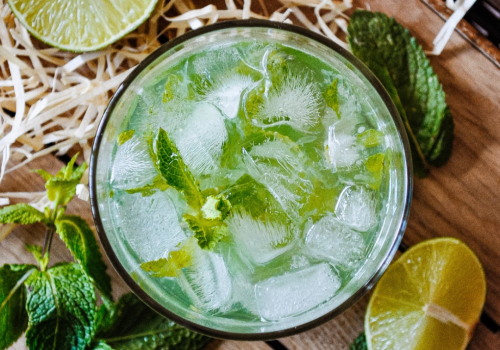GET LIMBER, WE HAVE JUST THE THING TO KEEP YOUR STEPS SPRINGY
YOUR MUST-READ GUIDE TO KEEPING THE SPRING IN YOUR STEP
We’re just going to put this one out there – when we get older, we can get less than spritely. We know, those silly clichés of clicking knees and groans about stiff backs are there to make us feel more than human, but the facts are that changes in muscles, joints, and bones happen with age, and these lead to weakness and compromised mobility.
If we look at the science, age-related changes going on in the makeup of our musculoskeletal system contribute to the many common chronic conditions that we see in older adults, especially those over the age of 65. But we need this complex musculoskeletal system to function in sweet harmony for normal joint motion and movement to happen, so it stands to reason that this is how physical function declines with age. (Cue those clicking knees.)
So, what is going on, on a musculoskeletal level? Well, depleted calcium and minerals, bone mass, and density all sadly decrease as we age, causing the bones to become brittle and in some cases, even compressed or curved. Meanwhile, joints become stiff as well as the fluids in the joints decrease, and then the cartilage in the joints rubs together and starts wearing away. As if that’s not enough, muscle mass also begins to decrease because of a lack of muscle tissue and the body begins storing fat in muscle tissue as muscle fibers shrink.
You see, the combo of bone, joint, and muscle changes can be at the root of pain and inflammation. So, let’s get into the promising benefits of CBD for joint health, but before that, we need some background on how these conditions impact women and the wide-ranging supports available.
The Prevalence of Joint Conditions Among Women
Let’s start by saying that studies have shown that women are more likely to suffer from joint pain compared to men, with around 60 % of all Americans impacted by joint pain being women. That might some depressing, but this gives us a great jump-off point because this is exactly why we need solutions fit for women and their anatomies. But first, here are the various factors that make women at a higher risk for developing joint pain:
- Estrogen: A hormone critical for cartilage protection, but we all know that estrogen levels decrease as we age, meaning the amount of cushioning and protection provided by the cartilage also drops. This causes a serious impact since estrogen levels are at their lowest during menstruation as well as during menopause.
- The female structure: Get ready to say a small cheer, because women have increased ligament and joint mobility compared to men, i.e., we’re generally more limber. The elasticity of the joints allows for more movement but on the downside, it also puts us at greater risk of developing joint pain.
- Obesity: Yup, obesity is a major factor in joint pain for both men and women, yet women experience a more significant risk of obesity than men. The reason why this is a problem is that obesity increases the risk of joint pain by placing a higher level of stress on the joints. Studies have shown that each additional pound of body weight equals four pounds of weight on the knees. Gasp!
The Most Common Musculoskeletal Disorders In Women
There’s a whole big picture thing for any complex health condition, including joint pain. Genetics, joint stability, and hormones all play a role in why musculoskeletal disorders impact women more than men. To get a full view, we’re diving into the most common conditions women experience:
Osteoarthritis is the most common joint disorder. Characterized by worn-down cartilage that leads to bones rubbing together, it has the painful result of swelling and stiffness, heralding significant joint pain. Women are four times more likely to develop this condition, and this risk goes up some more after the age of 55. In terms of where this presents itself, it’s commonly experienced on the hands or knees. Note, various endocrine conditions can also increase your risk of developing osteoarthritis.
Another big one, osteoporosis is the most common bone disease. Here, bones become fragile and more likely to break and you guessed it, 80% of individuals suffering from osteoporosis are women. Shockingly, about one in two women over the age of 50 will break a bone due to this condition and a woman’s risk of breaking a hip is equal to her risk of breast, ovarian, and uterine cancer combined! The symptoms of osteoporosis include changes in posture, loss of height over time, back pain, and increased bone fractures.
A slightly allusive one, we do know that stress fractures are more common among women than men. Despite this, the cause is unclear, yet researchers believe that biomechanics, hormonal environment, differences in bone density, or lower levels of general conditioning before training may all play a role. Interestingly, stress fractures are more common in active women and athletes.
We won’t mention those clicks again. But what we will say is that when compared to men, active women are more likely to experience patellofemoral pain and disruptions of the ACL. Researchers believe that this may be because of physiological and anatomical differences between women and men.
If you’re wondering what a bursa is, listen up. The condition known as bursitis is characterized by swelling and irritation of a bursa, AKA a fluid-filled sac that provides cushioning between muscles, joints, and tendons. This one is usually a temporary condition but annoyingly, it can limit motion and cause discomfort. Hip bursitis is more common in women and is often the result of overuse, arthritis, injury, spinal abnormalities, or surgery.
Did you know that rheumatoid arthritis is actually a chronic, autoimmune disease? It causes inflammation among the joints and surrounding tissue. Over time, the significant inflammation may also damage the joint tissue and impact mobility. It is more common among women and typically begins between the ages of 40 and 60.
If you were also thinking that gout was more common among men, think again. It has rocketed among women in the last 20 years with numbers more than doubling. This inflammatory form of arthritis causes joint swelling and severe pain at the base of the toe. Gout develops when significant levels of uric acid build up in the blood, creating (ouchy) needle-shaped crystals within the joints which lead to pain, redness, and swelling. Estrogen protects against uric acid (hooray) but when menopause occurs, estrogen levels drop and uric acid levels begin to rise, increasing our risk.
Ok, so maybe it sounds like our own bodies and age are stacked against us here, but so far, we haven’t taken account of the wonders of modern medicine and knowledge. Yes, many of these conditions develop due to age, but there are preventative measures you can take to optimize the health and wellness of your joints and your musculoskeletal system.
- Maintain a healthy weight: So, you know that obesity is a large risk factor for joint conditions (as well as other undesirable health conditions, guys). It’s simple, the more excess weight you carry, the more stress is placed on your joints and musculoskeletal system.
- Stay physically active: Staying active is the first port of call for maintaining joint mobility. Low-impact exercise is an ideal option with older age, especially for those already struggling with these conditions. You can read more about the benefits of exercise here.
- Strengthen your muscles: Here’s a call to action, because the earlier you start strengthening the muscles that surround your joints, the more it’ll pay off during your older years. Ultimately, it helps protect and reduce the amount of stress placed on your joints. Work with a physical therapist, personal trainer, or find free resources online for developing a strength routine.
- Prioritize a healthy diet: Another easy win – make sure you’re getting a balanced, healthy diet that’s nutrient-rich and includes calcium and vitamin D. This is particularly important for women undergoing menopause as this is when calcium and mineral levels decrease. Additional supplementation may also be a viable option – but be sure to discuss this with your healthcare provider.
- Instill healthy lifestyle habits: This means no smoking and limiting alcohol to help limit some of the risk factors that develop musculoskeletal conditions.
Sometimes pain relief is a good option for managing joint conditions, and where should you head to get this? Current pharmaceutical options for these types of age-related conditions include NSAIDs, prescription pain medication, steroids, DMARDs, hyaluronan injections, and chemotherapy drugs. But full disclosure, the long-term use of NSAIDs causes adverse side effects while increasing the risk of conditions like gastrointestinal bleeding, ulcers, strokes, heart attacks, and heart conditions. While we’re at it, the other prescription medications readily available have their own laundry list of undesirable side effects too, which are often exacerbated when taken with other medication.
While there still needs to be considerable research completed before we can make any definitive conclusions, the existing preclinical and anecdotal data is overwhelmingly positive. Endocannabinoids play an important role in the process of bone metabolism. Studies have shown that CBD may block an enzyme that destroys bone-building compounds in the body, helping reduce the risk of age-related bone diseases like osteoarthritis and osteoporosis. CBD may also promote new bone-cell formation, which speeds up the recovery process for fracture healing rates.
More and more studies are being conducted on CBD’s therapeutic promise for arthritic conditions ranging from rheumatoid arthritis to gout. The encouraging pain-relieving and anti-inflammatory properties may offer comprehensive symptoms management for a wide variety of joint disorders, offering a natural support option.
Some of the major risk factors for joint disorders are obesity and diabetes. CBD may reduce the risk of diabetes and obesity when combined with other healthy lifestyle habits. One study found that CBD may help the body convert white fat into weight-reducing brown fat, which promotes normal insulin production and sugar metabolism. Previous joint injuries can also increase the risk of developing arthritis in that joint. CBD may offer therapeutic promise for joint injuries, helping optimize recovery and potentially reduce this risk.
How to Use CBD for Joint Health
Before heading off on your CBD journey, remember that all cannabinoid therapy varies from person to person, and this applies to the subject of CBD and joint and muscle health too. It’s important to know that the results and effectiveness highly vary on the person, the administration method, product cannabinoid profile, timing, and dosage.
For musculoskeletal health, it’s recommended to take CBD consistently for potential preventative and overall wellness benefits. We also recommend taking CBD as needed to help prevent obesity which is a significant risk factor for women and joint conditions. But despite its promising results, also remember that you should never solely rely on CBD for improving your musculoskeletal health. It should be one of many self-care management tools used in combo with a healthy diet, exercise, and lifestyle habits.
To start, self-experiment with dosage and timings to find what works best for you. To understand the effects of any new supplementation, it’s a good idea to keep a journal tracking your dosage, timing, and any risk factors you have. This can give you a clear set of data points for creating the proper CBD regimen for heart health, stress, and other contributing factors, and this allows you to better understand how it affects you.
Also note, if you are taking any medication for existing joint disorders, it’s vital to speak to your doctor before trying CBD since it can cause drug interactions.
Press Pause for Joint Health
As women, we have a first-hand appreciation of the nuances of our body chemistry and how it impacts our search for optimizing our musculoskeletal health in old age. If you’re feeling stuck, know that we’re always happy to help you find the right products for supporting joint, bone, and muscle health.
Click below for joint health products.







